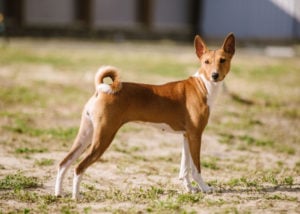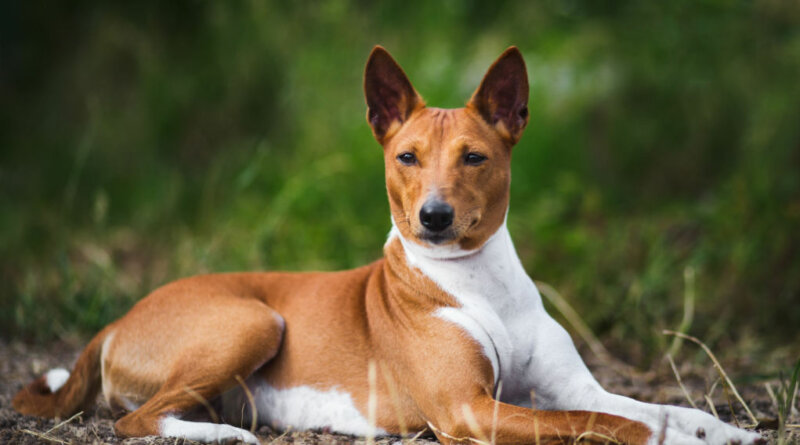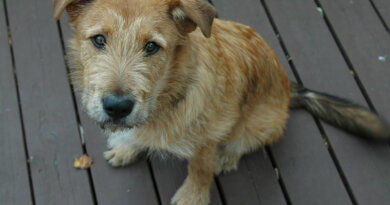Basenji Dog Breed Profile – Top Dog Tips
Basenji, Congo Terrier, Bengali Dog, the African Barkless Dog… Whatever name you want to call them, there’s no doubt this canine breed is a wonder on its own.
They’re mostly described as independent, smart, and poised dogs.
And did you know they are even considered contenders for the title of oldest AKC breed? This breed goes way, way back, possibly even older than ancient Egypt!
Sounds interesting, right?
In this article, let’s get to know more about the rich origin of the Basenji, where they came from, their temperament, characteristics, and basically, what makes the Basenji unique from all the other dog breeds.
Basenji Dog Breed: An Overview
Natural hunters from the Hound family, Basenjis are relatively smaller compared to their cousins.
Standing at 16 to 17 inches from the shoulder, they are most
The American Kennel Club described the standard Basenji as short-backed, lightly built, appearing high on the leg compared to its length.
Their wrinkled forehead also gives off an almost human-like expression of inquisitiveness and alertness.
And if you’re wondering, it’s true that they can’t bark.
Because of their unusually shaped larynx (voice box), they produce sounds that are more similar to a whine, scream, or yodel.
Male Basenjis can weigh up to 24 pounds, while female Basenjis at 22 pounds. When cared for properly, this breed can have a 13 to 14 years lifespan.
The Basenji Dog Breed Origin
The name Basenji was derived from the words “mbwá na basɛ́nzi,” a local Bantu term of the northeastern Congo region for “dog of the savages” or “dog of the villagers.”
Other interpretations of their name are “wild dog,” “savage dog,” and “the dog that jumps up and down.”
This breed goes way back that paleontologists even found traces of ancient, domesticated dogs having similar features to the Basenji.
They are already well established as hunting dogs in Africa when they were brought to Egypt (via the Nile river, nonetheless!) as gifts to the pharaoh.
While the glorious era of Ancient Egypt collapsed, the Basenji breed mostly continued to live as versatile hunters for the African people, but others live in a semi-feral state.
A Basenji pair was eventually brought over to England in 1895 and 1937, but among those pair and their litters, only one male Basenji survived named Bois.
Bois was brought over to the US by a Bostonian breeder and was bred with a female named Congo. They became the parents of the first Basenjis in the United States.
Basenji Dog Breed: Traits and Characteristics
The typical Basenji color combination comes in 9 variations. However, the American Kennel Club only recognizes 4 of them as the standard color.
Those are:
- Black and White
- Black Tan and White
- Brindle and White
- Red and White
While the non-standard colors are:
- Black Brindle and White
- Cream and White
- Sable and White
- Blue Cream and White
- Mahogany Tan and White
Basenjis also usually have the standard Brindle markings, but other acceptable markings are Black Mask, Black Saddle, and With Cap.
Their coats are short and fine and their skin is very pliant. Because of this, they are fairly easy to groom as they don’t shed that much.
They’re also known for their sharp eyes. That’s Basenji’s main hunting tool, after all. They can easily spot motion and chase after it.
The Basenji’s most notable feature, however, is their yodeling. If you haven’t heard one yet, check out this video below!
Adorable, right?
Since Basenjis are excellent watchdogs, they’d most likely do this sound to alert you if there are strangers around.
Basenjis also have a high-energy level, although not as quite intense as the other hounds.
They’re also highly adaptable. Because of their size, they can do well in apartment living and small living spaces.
Basenji Dog Breed: Personality and Temperament
Funnily enough, Basenjis can be compared more to cats than dogs. Why? They know how to groom themselves, for one.
Personality-wise, they are quite independent and intelligent that they’d have to think first if they want to do what you want them to do before they do it (or not).
In short, you can only make suggestions, but never a command.
Basenjis are also known as escape artists. They’re capable of hatching a plan to get what they want.
You’d also have to be wary of smaller pets around them especially if they didn’t grow up with them. Because they are hound dogs, they have the natural instinct to hunt smaller prey.
However, Basenjis can also be well-rounded too. They’d need a lot of patience to learn, sure.
But if they are socialized and trained at an early age, they’d be the perfect house pets you could ever have.
They are loyal, and they consider themselves part of the family. You are part of their pack, so they’d be with you no matter what.
Basenji Dog Breed: Care Needs
Basenjis are fairly easy to care for in terms of grooming and feeding. What you’d really want to focus on is mostly their physical and training needs.
Grooming Needs
As mentioned, Basenjis have this cat-like habit of grooming themselves, so they actually don’t need that much in this department.
You’d only need to brush their coats once a week using a soft bristle brush or a grooming hand glove.
And because they don’t have that ‘doggy smell’ like the other breeds, they don’t need to be groomed as much, only when they get messy from their activities.
You can still bathe them though for at least every few months.
Owners who like to keep their house clean would appreciate the short coat of Basenjis because they don’t shed that much (or at least, not as visible as with the other breeds.)
Just make sure to keep their nails trimmed and their teeth brushed regularly to avoid any complications that may come from them.
It is ideal to clean their teeth 2 to 3 times a week to avoid tartar buildup.
Although they don’t need much grooming, it’s still best to get them used to it starting at an early age so you won’t have any difficulty doing so later on.
Feeding Needs
Either commercially available or home-prepared meals will sit well with a Basenji, just as long as they’re high-quality and nutritious.
If you opt for dry food, a 3/4 to 1 cup of it divided into 2 meals should be enough per day.
It’s also recommended to keep them on a feeding schedule instead of just letting them eat whenever they want.
Although they’re not as prone to getting overweight as others, watching what they eat will help in keeping them in tip-top shape.
Physical Needs
Basenjis are energetic and you would need to help them find the perfect activity to spend their high levels of energy.
They need at least 40 minutes of exercise per day, and training is more of a necessity than a recommendation for them.
However, because they are intelligent, they’d get easily bored with repetitive training.
Make sure to keep it fun and interesting for them and not make it too long or your Basenji would get easily bored.
Just a heads-up though, they can suddenly develop selective hearing especially when they see something more interesting than the training!
Possible Health Issues of the Basenji Dog Breed
Although they are generally healthy dogs, Basenjis still have a couple of possible health concerns you may want to look out for, just like any other purebreds.
It’s best to have them undergo tests early on to immediately diagnose and address whatever condition they may have.
The following are only some of the most common health issues observed by experts among the Basenji breed.
Fanconi Syndrome
A common kidney disease in Basenjis, the Fanconi Syndrome makes the dog urinate all the protein he needs to survive.
Some indicators of Fanconi Syndrome are drinking and urinating more than normal.
If lab tests are done, a high level of glucose present in the urine but not in the blood definitely creates suspicion of this disease.
This disease normally manifests at 3 to 4 years old.
Fanconi Syndrome was also once considered fatal, but luckily, there are available procedures now for proper management.
Just to be clear though, this is still not a treatable disease. Managing Fanconi Syndrome can only prolong the life expectancy of dogs with this illness.
Progressive Retinal Atrophy (PRA)
An eye disease common to most dogs, Progressive Retinal Atrophy (PRA) is a degenerative disease of the eye wherein dogs develop blindness.
PRA usually starts as night blindness, until it progresses into full-blown blindness.
While blindness isn’t a major problem for most dogs (they mostly rely on their sense of smell), this can be a big adjustment for your sighthound Basenji, who is known for its sharp eyes.
Basenji Enteropathy
Mostly considered hereditary although there really is no definitive cause yet, Immunoproliferative Enteropathy, also known as the Basenji Enteropathy, is a dangerous inflammatory bowel disease first seen in Basenjis before getting detected in other breeds.
If not addressed at once, this disease has the potential to affect all body functions and vital organs including the heart, lungs, kidney, and liver due to malabsorption.
Severe diarrhea and vomiting are also some of the common symptoms of Basenji Enteropathy and may cause serious dehydration if not treated.
Apart from these common health problems among Basenji, there are also some minor concerns to look out for such as Persistent Pupillary Membrane (PPM), Erythrocytic Pyruvate Kinase (PK) Deficiency, Hypothyroidism, and Umbilical Hernia.
Some recommended tests from the Basenji Club of America, Inc. are:
- Hip Evaluation
- Thyroid Evaluation
- PRA-BJ1 DNA Test
- Fanconi Syndrome DNA Test
- Ophthalmologist Evaluation
Basenji Dog Breed: Fun Facts!
- Basenji dogs go way back and this breed inspired several mythological characters in some cultures. One is Anubis, the Egyptian god of mummification and the afterlife, and the other is Rukuba, the talking Basenji pet of the Nyanga fire god Nyamuriri.
- In 2015, there are around 8 million mummified dogs found in Egyptian catacombs, and most of them are believed to be Basenjis. This ritual is believed to allow the dogs to come to the afterlife with their owners.
- Basenjis were once bred to serve as bait to trap lions in Africa.
- Many novels and movies have featured different Basenji characters like the 1956 movie adaptation of the novel Good Bye, My Lady.
FAQs on Basenji Dog Breed
Is Basenji a Good Family Dog?
Yes, Basenji can make a good family dog.
Although they were originally bred as hunting dogs in Africa (up to this day, actually!), most Basenjis in the United States are house-trained to become good family dogs.
Basenjis are fiercely loyal and protective of their owners so early socialization is important to make them good dog companions.
Is Basenji a Rare Dog?
Basenjis are rather uncommon in the United States. In fact, among the 155 breeds and varieties recognized by the American Kennel Club, Basenji is the 84th in rank.
One factor that is said to be affecting this status is their breeding behavior.
Female Basenjis come into heat only once a year unlike most dogs, and the most litter they can produce is between 5 to 7 puppies.
Do Basenjis Like to Cuddle?
Although Basenjis are independent creatures, they can be very cuddly with people they are most comfortable with.
If they grow up with another Basenji, you’ll mostly see them either cuddled together or grooming each other.
And speaking of grooming, Basenjis are almost odorless because they can self-groom which makes them the perfect cuddle-buddy!
Basenji Dog Breed Profile — Final Thoughts
Basenji would be the perfect breed if you want a dog that’s not only smart and make for perfect watchdogs, but also comes with an interesting history and role in traditional and popular culture.
Remember though that the traits and characteristics, personality, and temperaments in this article are just a general idea of what Basenjis are like.
Dogs still have their individual personalities which makes them unique from others.
Basenjis may come across as strong-willed and too independent, but once you get to peel back their layers, you’ll get a loyal and fierce companion in them.
READ NEXT: Hunting Hound Dogs
Related








acarbose kaufen